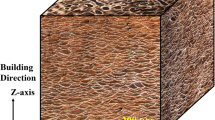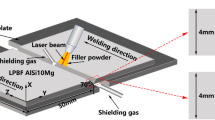Abstract
Fusion welding in aluminium alloys had always remained an issue for aero- and auto industries. An Al–3Mg–0.25Sc alloy is classified as weldable aluminium alloys. In this study, two welding techniques, keyhole and conduction welding, have been used for joining Al–3Mg–0.25Sc sheets of thickness 1.6 mm. Experiments were carried out using different beam diameter (0.16–2 mm dia), beam power (2–4.5 kW) and laser head speed (ranging from 0.5 to 6 m/min). The results for all autogenous keyhole welding clearly demonstrated a drop in ductility (< 0.8%) compared to base metal for all beam power and welding speed combinations although the yield strength was reasonably good (175–180 MPa, i.e. > 50% of base metal). Residual stress-induced distortions affected the final shape of the product, and for that, a suitable stress relief annealing was also required. Hereby, we chose two heat treatment schedules: (1) solution treatment and annealing and (2) retrogression and re-ageing. Retrogression and re-ageing is a precipitation-controlled phenomenon and comprises of an intermediate annealing step between tempering and solutionizing temperature to dissolve the nano-clusters present in the matrix (retrogression) and re-precipitating and growing them by ageing (re-ageing). These two steps were repeated cyclically, and as a result, the strength (190 MPa) and ductility (~ 9%) of the material were improved substantially. The improvement of ductility and strength was explained in detail in the light of microstructural studies.








Similar content being viewed by others
References
Jakab P L, J Aircr36 (1999) 914.
Grosz P, and Terry G, The Way to the World’s First All-Metal Fighter, AirEnthusiast Twenty-Five, Pilot Press, Norfolk (1984), p 60. ISSN 0143-5450.
Munroe J, Wilkins K, and Gruber M, Integral Airframe Structures (IAS)—Validated Feasibility Study of Integrally Stiffened Metallic Fuselage Panels for Reducing Manufacturing Costs, NASA/CR-2000-209337 (2000).
Pettit R G, Wang J J, and Toh C, Validated feasibility study of integrally stiffened metallic fuselage panels for reducing manufacturing costs. Final Report, NASA Contract NAS1-20014, Task 34, The Boeing Phantom Works (Long Beach), November 1998 (2000).
Murphy A, McCune W, Quinn D, and Price M, Thin-Walled Struct45 (2007) 339.
Barat K, and Venkateswarlu K, J Laser Appl31 (2019) 032012.
Murphy A, Lynch F, Price M, and Gibson A, Proc Inst Mech Eng G J Aerosp Eng 220 (2006) 267.
Rohde M, Markert C, and Pfleging W Int J Adv Manuf Technol50 (2010) 207.
Braga D F, Tavares S M O, da Silva L F, Moreira P M G P, and de Castro P M, Prog Aerosp Sci69 (2014) 29.
Nélias D, Jullien J F, and Deloison D, Mater Sci Eng A527 (2010) 3025.
Widener C A, Burford D A, Kumar B, Talia J E, and Tweedy B, in Materials Science Forum, Trans Tech Publications (2007), vol 539, p. 3781.
Feng J C, Rathod D W, Roy M J, Francis J A, Guo W, Irvine N M, Vasileiou A N, Sun Y L, Smith M C, and Li L, Int J Press Vessels Pip157 43.
Chen X, Liu Z, Lin M, Ning A, and Zeng S, J Mater Eng Perform21 (2012) 2345.
Ghosh K S, Das K, and Chatterjee U K, Mater Sci Technol20 (2004) 825.
Suder WJ, and Williams SW, J Laser Appl24 (2012) 032009.
Meco S, Pardal G, Ganguly S, Williams S, and McPherson N, Opt Lasers Eng67 (2015) 22.
Ahn J, He E, Chen L, Dear J, and Davies C, J Manuf Process29 (2017) 62.
Merklein M, Böhm W, and Lechner M, Phys Procedia39 (2012) 232.
Dittrich D, Schedewy R, Brenner B, and Standfuß J Phys Procedia 41 (2013) 225.
Acknowledgements
This project is funded by AR & DB (Aeronautics Research and Development Board), Government of India, New Delhi, under the Grant No. 1811. Authors would like to thank Dr. Gautam Patil for conducting LBW experiments at M/S laser line, Pune. We thank Dr. M. Sujata and Dr. S.K. Bhaumik for their constant support in execution of this research work. Authors would also like to thank Dr. S. Ravi Shankar and S. V. Anban for technical help and guidance.
Author information
Authors and Affiliations
Corresponding author
Additional information
Publisher's Note
Springer Nature remains neutral with regard to jurisdictional claims in published maps and institutional affiliations.
Rights and permissions
About this article
Cite this article
Barat, K., Panbarasu, K., Bathe, R. et al. Influence of Post-Weld Processing Techniques on Laser Beam-Welded Al–3Mg–0.25Sc Alloy Sheets. Trans Indian Inst Met 73, 1461–1468 (2020). https://doi.org/10.1007/s12666-020-01891-2
Received:
Accepted:
Published:
Issue Date:
DOI: https://doi.org/10.1007/s12666-020-01891-2




